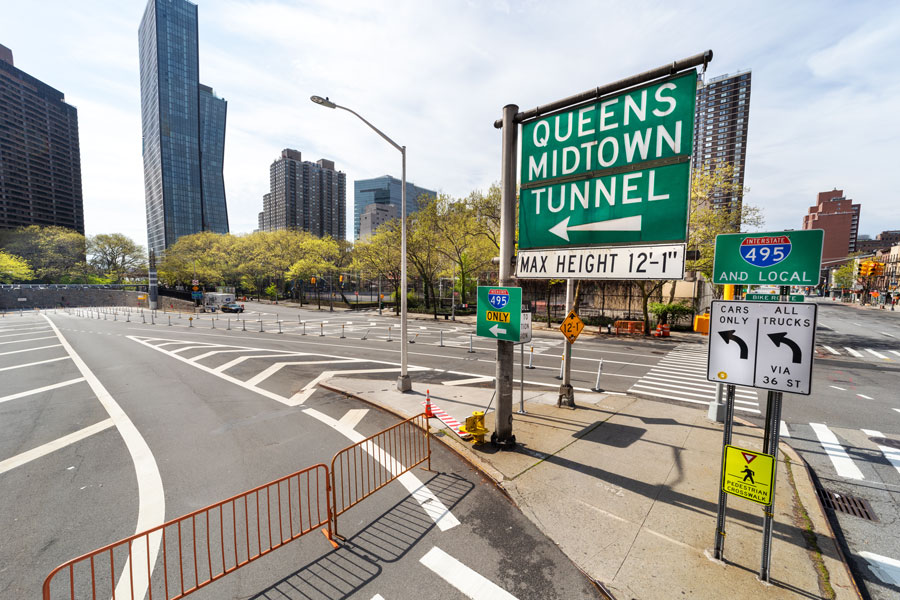Queens–Midtown Tunnel

The Queens–Midtown Tunnel, often simply called the Midtown Tunnel, is one of New York City’s most important vehicular connections between Manhattan and Long Island. Opened in 1940, the tunnel links Midtown Manhattan at 36th Street directly to Long Island City in Queens, offering a direct route under the East River. Operated by the MTA Bridges and Tunnels, it remains a critical access point for commuters, commercial vehicles, and visitors traveling to and from Long Island.
History
- Construction & Opening: Built during the late 1930s and completed in 1940, the tunnel was a major engineering achievement of its time. It was designed by Ole Singstad, a renowned tunnel engineer who also worked on the Lincoln Tunnel.
- World War II Era: Its construction and completion provided an important transportation link during wartime, supporting both military logistics and local travel.
- Modern Upgrades: The tunnel has undergone significant renovations, including flood protection systems after Hurricane Sandy in 2012, and modern tolling technology.
Design & Features
- Twin Tubes: The tunnel consists of two tubes, each carrying two lanes of traffic, for a total of four lanes.
- Length: Roughly 6,400 feet (1.2 miles) long, making it one of the longest continuous underwater vehicular tunnels in North America when it opened.
- Tolls: The tunnel is electronically tolled via E-ZPass, with no cash collection points.
- Restrictions: Trucks are permitted but must follow specific size and weight guidelines. Hazardous materials are prohibited.
Importance for Long Island Travelers
For anyone traveling from Manhattan to Long Island, the Queens–Midtown Tunnel is one of the most direct and convenient options. Unlike the Queensboro Bridge, which leads into local streets and heavier traffic patterns, the Midtown Tunnel provides a quick path into Queens and access to major roadways such as:
- Long Island Expressway (I-495) – directly connects the tunnel to Long Island’s main highway.
- Brooklyn-Queens Expressway (BQE/I-278) – accessible shortly after exiting in Queens.
This makes the tunnel a preferred choice for drivers heading deeper into Nassau and Suffolk Counties.
Nearby Landmarks
- Manhattan Side: Located near Murray Hill, Kips Bay, and the East 34th Street Ferry Terminal.
- Queens Side: Connects into Long Island City, a rapidly developing neighborhood known for its skyline views, art scene, and business centers.
Q&A – Queens–Midtown Tunnel
Q: How much is the toll for the Queens–Midtown Tunnel?
A: Toll rates vary depending on E-ZPass vs. Tolls by Mail, vehicle type, and residency discounts.
Q: Can pedestrians or bicycles use the tunnel?
A: No, the Queens–Midtown Tunnel is strictly for motor vehicles.
Q: Does the tunnel connect directly to the Long Island Expressway?
A: Yes. The Queens–Midtown Tunnel provides a seamless connection from Midtown Manhattan onto the Long Island Expressway (I-495), the main highway into Nassau and Suffolk Counties.
Q: Is the tunnel prone to flooding?
A: After Hurricane Sandy, major flood protection measures were installed, including storm surge barriers and reinforced pumping systems, making it far more resilient.
Area Snapshot
| Feature | Details |
|---|---|
| Opened | 1940 |
| Length | ~6,400 feet (1.2 miles) |
| Lanes | 4 (two in each tube) |
| Operator | MTA Bridges & Tunnels |
| Primary Connection | Manhattan (36th Street) ↔ Long Island City (Queens) |
| Highway Access | Long Island Expressway (I-495) |
The Queens–Midtown Tunnel has been a vital link between Manhattan and Long Island for over 80 years. Its strategic location, direct connection to the Long Island Expressway, and ongoing infrastructure improvements make it one of the most efficient and reliable crossings in New York City. Whether you’re commuting daily, heading out for a Long Island getaway, or traveling for business, the tunnel remains a trusted gateway between borough and suburb, underscoring its role as an essential part of the region’s transportation network.

